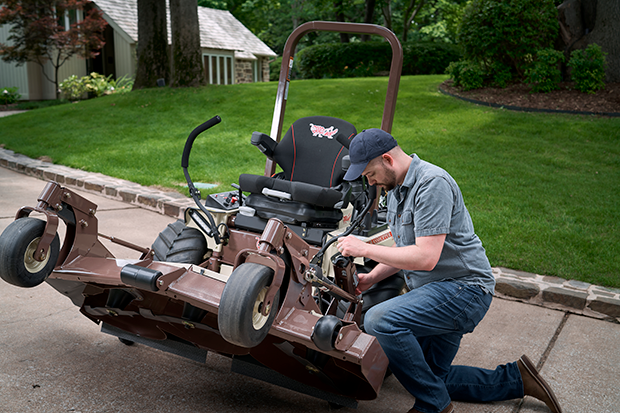
It’s never too early to think about spring, especially when it comes to preparing your mower fleet.
For parts of the U.S., spring might feel light-years away, but rest assured the busy season is right around the corner. Experts say now more than ever, contractors must prepare their mowers for a heavy workload in the spring.
“It sets the foundation for the busy spring cleanup season and the mowing season,” Justin Green, customer service manager with Briggs & Stratton, says. “Spring maintenance is for making sure your equipment is in good condition and ready for the season so that you don’t have breakdowns because breakdowns can get costly — not just in time, but also in getting the work done.”
Whether it’s a zero-turn, stand-on or a walk-behind mower, preseason maintenance is important.
LM spoke with Green and Michael Simmon, marketing communications specialist for Grasshopper Mowers, about why spring maintenance is so critical and what contractors should be doing as they prep their mowers.

Easy to overlook
Grasshopper’s Simmon recommends keeping a maintenance log to make sure maintenance — such as oil changes and air filter replacements — takes place when it needs to. The company also has a mower prep checklist online for contractors to consult as they gear up for the spring.
Simmon also advises consulting service manuals for specifics when it comes to procedures, schedules and replacement part lists.
“Use only original equipment manufacturer (OEM) replacement parts, as OEM parts are designed to work in conjunction with specific systems,” he says.
Green agrees, saying the service manual is a great first place to check when starting spring maintenance.
“It’s too often that once the season gets going those things are going to get missed or put off,” he says. “They’ll say, ‘I’ll do it when it’s raining,’ and then it just never gets done.”
Different mowers
No matter the type of mower, regular maintenance is important. But does the type of mower change the maintenance needs? Not really, according to Green.
“They all have something that might drive the wheels, whether it’s a transaxle or a pump and wheel motor system, they all have a belt there. They all have recommended oil change intervals or inspection intervals,” he says. “So, really, the type of mower doesn’t change the basic maintenance of that mower. They all have the same basic components that all need to be checked.”
Supply chain woes
Supply chain interruptions played a major role in parts availability in 2021. With no signs of that issue ending soon, it promises to be an even bigger problem this year.
“The availability of any number of different parts could be affected at any time. The best way for you to insulate yourself from parts supply disruptions is to stock up now on wear items such as belts, blades and filters,” says Simmon.
As the mowing season kicks off, the demand for those items could increase and, in turn, increase prices and wait times for delivery. Experts say it’s more important than ever to order ahead and put a premium on winter and spring maintenance. A maintenance problem that was a small inconvenience in the past could become a major problem this year.
Green agrees, saying, “Those that wait until the last minute are going to feel the biggest pain when it comes to the supply chain.”

